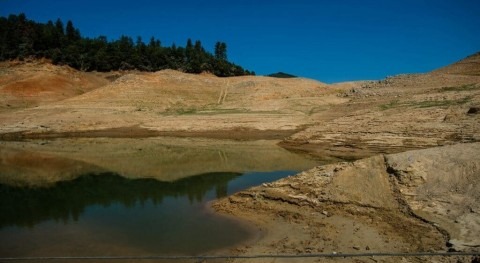Using data gathered by satellite, North Carolina State University researchers found that higher elevation forests in the Blue Ridge Mountains are often maintaining, and sometimes even increasing, their water use during extreme droughts.
Published in the journal Landscape Ecology, the findings suggest upstream forests' increased water consumption could leave less water downstream for forests, cities and wildlife during drought.
"We're expecting that droughts will become more severe and frequent, so it's important to understand how that's going to influence the amount of water we have available," said the study's lead author Katie McQuillan, a graduate student in the Center for Geospatial Analytics at NC State. "We found that these forests are using more water on average during droughts, and that leads to less water ending up downstream."
In the study, researchers analyzed how trees use water and release it as vapor based on thermal infrared remote sensing data gathered by satellites between 1984 and 2020. They used that data to understand trends in forest water use for more than 15,000 square miles of forest in the Blue Ridge Mountains across Virginia, North Carolina, Tennessee, South Carolina and Georgia.
"Forested mountain regions are super important for the quality and quantity of water that we have downstream," McQuillan said. "Mountain forests produce some of the cleanest and most stable sources of water, and have an impact on how much water is available downstream for people and aquatic species."
In part of their analysis, they tracked whether forests used more or less water than normal for each pixel of mapped land—averaged based on elevation—in moderate, severe and extreme droughts.
They found that higher elevation forests' average water use was generally unchanged or slightly increased during extreme droughts. Those forests, which made up about 22% of the forest area they studied, tended to be located above 3,280 feet. Meanwhile, they found that lower elevation forests reduced their water use on average.
"Higher elevations are finding droughts more stressful, so they're using more water every time there's a drought," said the study's senior author Katherine L. Martin, assistant professor of forestry and environmental resources at NC State. "These high elevation and ridge forests are able to increase water use because they have first access to precipitation. With less runoff, that makes dry conditions for trees at lower topographic positions worse, leading to larger declines in forest water use in low elevation and valley forests."
Lower water consumption by lower elevation forests could mean they are less adapted to drought.
"The processes of tree water use and growth are coupled, so when a tree reduces its water use it is also reducing growth," McQuillan said. "More drought-adapted trees are typically able to continue using water, and growing, under greater water stress than less drought-adapted trees."
Overall, across all elevations, researcher saw that mountain forests drank above average amounts of water at the droughts' peak. Researchers said rising temperatures due to climate change likely play a role.
"We think that increasing temperatures are behind greater water use during droughts," McQuillan said. "When it's hotter, forests use more water to keep themselves cool."
Changes in the types of trees found in the forests—due to fire suppression and changes in precipitation or other trends—could also be playing a role in their findings, researchers said. Drought sensitive species like maples and tulip poplars, which have historically been found at lower elevations, are now more common throughout the landscape.
"There are species that use a lot more water than others," McQuillan said. "If those are in the high elevation or upslope areas, that exacerbates what we're seeing."
The findings could mean that changes in the way forests use water would make water shortages more severe.
The study, "Forest water use is increasingly decoupled from water availability even during severe drought" was published online in in Landscape Ecology on Feb. 27, 2022.










